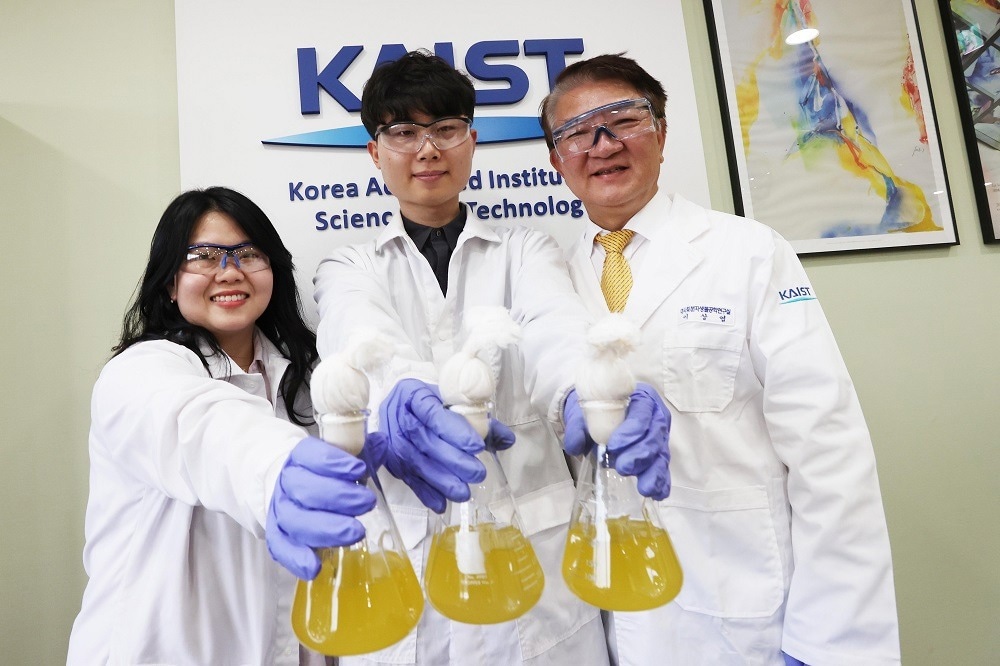Reviewed by Lexie CornerNov 11 2024
The world is currently confronting significant environmental challenges due to plastic waste. A research team at KAIST has developed a microbial-based biodegradable plastic that has the potential to replace polyethylene terephthalate (PET) bottles, representing a notable breakthrough. The study was published in the Proceedings of the National Academy of Sciences of the United States of America.
 (From left) Dr. Cindy Pricilia, Ph.D. Candidate Cheon Woo Moon, Distinguished Professor Sang Yup Lee. Image Credit: Korea Advanced Institute of Science and Technology
(From left) Dr. Cindy Pricilia, Ph.D. Candidate Cheon Woo Moon, Distinguished Professor Sang Yup Lee. Image Credit: Korea Advanced Institute of Science and Technology
Professor Sang Yup Lee's team from the Department of Chemical and Biomolecular Engineering has developed a microbial strain capable of efficiently producing a pseudoaromatic polyester monomer as a substitute for PET through metabolic engineering.
Pseudoaromatic dicarboxylic acids, when polymerized, offer superior physical properties and enhanced biodegradability compared to PET, making them a promising eco-friendly monomer for polymer synthesis. However, the chemical production of these dicarboxylic acids faces challenges, including low yield, poor selectivity, complex reaction conditions, and the generation of hazardous waste.
To address this challenge, Professor Sang Yup Lee's research team utilized metabolic engineering to develop a microbial strain capable of efficiently producing five types of pseudoaromatic dicarboxylic acids. These include 2-pyrone-4,6-dicarboxylic acid and four pyridine dicarboxylic acids (2,3-, 2,4-, 2,5-, and 2,6-pyridine dicarboxylic acids) in Corynebacterium, a bacterium commonly used for amino acid production.
The team applied metabolic engineering techniques to create a platform microbial strain that enhances the metabolic flow of protocatechuic acid, a precursor for several pseudoaromatic dicarboxylic acids, while preventing precursor loss.
Through transcriptome analysis, the team identified targets for genetic manipulation and successfully produced 76.17 g/L of 2-pyrone-4,6-dicarboxylic acid. Additionally, by discovering and constructing three new metabolic pathways for pyridine dicarboxylic acid production, they were able to produce 2.79 g/L of 2,3-pyridine dicarboxylic acid, 0.49 g/L of 2,4-pyridine dicarboxylic acid, and 1.42 g/L of 2,5-pyridine dicarboxylic acid.
The research team confirmed the production of 15.01 g/L of 2,6-pyridine dicarboxylic acid by constructing and enhancing the biosynthesis pathway for this compound, successfully producing all five pseudoaromatic dicarboxylic acids with high efficiency.
In conclusion, the team achieved the highest concentrations of 2,4-, 2,5-, and 2,6-pyridine dicarboxylic acids ever recorded. Notably, 2,4- and 2,5-pyridine dicarboxylic acids were produced at gram-per-liter scale, marking a significant improvement over the previously achieved low production levels (mg/L).
This study is expected to have broad applications in polyester production processes and contribute significantly to the research on the production of similar aromatic polyesters.
The significance lies in the fact that we have developed an eco-friendly technology that efficiently produces similar aromatic polyester monomers based on microorganisms. This study will help the microorganism-based bio-monomer industry replace the petrochemical-based chemical industry in the future.
Sang Yup Lee, Professor and Study Corresponding Author, Korea Advanced Institute of Science and Technology
This study was conducted with support from the Development of Next-generation Biorefinery Platform Technologies for Leading Bio-based Chemicals Industry project and the Development of Platform Technologies of Microbial Cell Factories for the Next-generation Biorefineries project (Project leader: Professor Sang Yup Lee), funded by the National Research Foundation under the Ministry of Science and Technology and ICT of Korea.
Journal Reference:
Cho, J. S., et al. (2024) Metabolic engineering of Corynebacterium glutamicum for the production of pyrone and pyridine dicarboxylic acids. Proceedings of the National Academy of Sciences. doi.org/10.1073/pnas.2415213121.